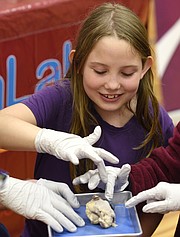BRAIN CANDY
Educators Michael Jahnke and Eliel Anttila got inside the heads of Olney-Bissell School students Thursday.
Jahnke and Anttila brought with them “Brain: A World Inside Your Head,” a Montana spectrUM Science Experience. SpectrUM is a University of Montana program bringing science exhibits to rural schools across the state.
At different interactive stations placed around the school gym, students learned how the brain processes visual and sensory stimuli.
A highlight of the brain science exhibit was a table with jars and vials of preserved animal and insect brains and a cow’s eyeball placed in the center of a dissecting pan.
A group of excited Olney-Bissell fourth-graders sat around the table and had varied reactions as Jahnke sliced open the eye with a scalpel, revealing the layers that make up the second most complex organ after the brain.
Carefully, Jahnke separated the vitreous humor — a clear, egg-yolk like part of the eye — and handed it to the students to touch.
“It’s kind of like touching Jell-O,” fourth-grader Guinivere Hannigan said.
Following the fourth-graders, a group of sixth-graders watched Anttila dissect an eye with eager interest and also learned about eye anatomy. Afterward, sixth-grader Camas Poteet stayed back to take a closer look at the preserved brains and attempt to guess what animal each one came from.
“That one has to be a sort or rodent,” Poteet said looking at a brain that was smooth and noticeably missing the wrinkles seen in a human brain. “A ferret?”
Anttila said the guesses were close, but it was a rabbit.
“What, really,” Poteet said.
Anttila explained the smooth texture of the rabbit brain versus animals that have many wrinkles tied to intelligence.
“The more surface area the brain has the more area you have for a multitude of connections — neurons. So the human brain is very intricate,” Anttila said.
When asked how she knew some of the animal brains, Poteet said she has seen a lot of medical pictures sent by her grandmother who was a surgeon in New York. Poteet also is also interested in medicine and has aspirations of becoming a cardiovascular surgeon.
Having learned how vision passes through the parts of the eye through the dissection students moved on to learn how images are processed in the brain. At one station a pair of goggles reversed student’s vision. Jahnke told fourth graders a story about a researcher who had a man wear similar goggles and how his brain adapted.
“He wore them for long enough that his brain realized that and flipped the image to right-side-up again. Do you know that we actually see everything upside down,” Jahnke said.
This is one reason why the part of the brain that processes vision, the occipital lobe, is located in the back of the brain in order to provide time — although too quick to be noticed — to flip the image as it travels through the optic nerve Jahnke explained as a segue to talking about brain plasticity.
“What’s plastic what do we use plastic for,” he asked receiving some answers. “We can form plastic into almost anything we want right? So it’s a similar thing with our brains. Our brains are really plastic, which means that they can adjust to things really quickly.”
At another station, students isolated or manipulated their different senses — smell, taste, hearing, touch and vision.
At a hearing activity, Hannigan and another fourth-grader put on noise canceling earmuffs. Picking up tuning forks they hit them against the table edge and were told to place it against their temples.
“If you put it against your temple touching the bone, it’ll vibrate the bone, which vibrates your inner ear,” Jahnke said. “So, without the sound waves traveling into your ear it’s doing the same thing through vibrations and you’re hearing the notes.”
In a smelling activity, students put their noses over holes in a wooden box and tried to discern different smells without seeing the objects. At another station a student tried to trace a star by only looking at a mirror image.
The interactive stations are something students can easily connect how the brain “is in charge of interpreting all that sensory information,” Jahnke said.
Sixth-grader Elijah Spear said he learned a lot about the brain after going through the stations learning that it’s one “really cool” yet fragile organ.
Hilary Matheson is a reporter for The Daily Inter Lake. She may be reached at 758-4431 or hmatheson@dailyinterlake.com.




